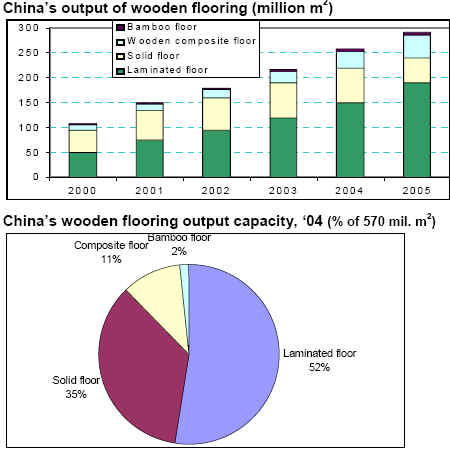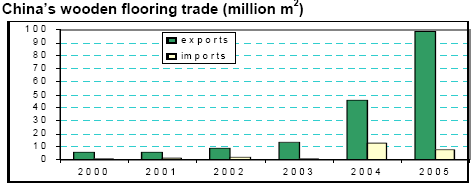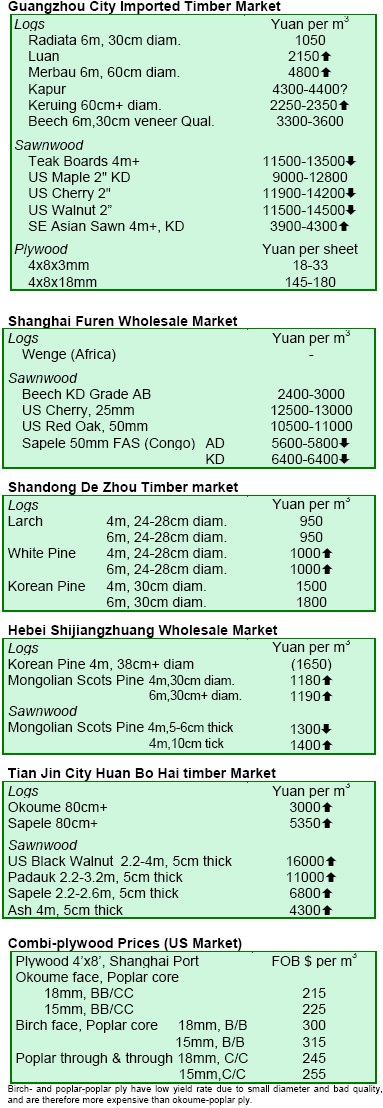|
US
Dollar Exchange Rates of 29th Sep. 2006
China Yuan
7.904
Report from China
China adjusts export tax rebates on wood products
China said it would adjust its tax export system to discourage exports of some low-end products and commodities and encourage exports of high-tech products and other high-end goods effective from 15 September. The export tax rebate rates for the following goods had been reduced:

Export tax rebates on the following goods had been
abolished:
. All
non-metallic minerals listed under Customs Chapter 25 of the tariff code
except salt, cement, coal, natural gas, paraffin, asphalt, silicon,
arsenic, stone materials, nonferrous metal and scraps.
. Metallic
ceramics, some pesticides, some finished leather, lead-acid batteries and
mercury-oxide batteries.
. Fine goat
wool, fuel wood, wood sleepers, corks and some
primary wood products.
Export tax rebate rates for the following goods had
been raised:
China had abolished export tax rebates on sawnwood and solid floors in recent years due to domestic timber shortage. In addition, China had also abolished 13% of export tax rebates on paper pulp, paper and paper board made from imported logs, wood chips and commercial pulp.
China needs 5 mill. m3 more of tropical timber by 2010
China's imported tropical timber is mainly used to produce face and back of plywood and blockboard, solid furniture and as raw material for construction, interior decoration and home improvement. Thus, China¡¯s demand for tropical timber depends on the development of these sectors.
According to local analysts, timber demand for plywood and blockboard, solid flooring, furniture and other end-uses would be 40 million m3 (of which 8 million m3 tropical timber), 60-70 million m2 (1.5 million m3 of tropical timber) and 21 million m3 (5 million m3 tropical timber), respectively by 2010. Adding another 1.5 million m3 for other end uses, 16 million m3 of tropical timber would be needed by that year. In 2005, China's tropical log imports reached 7.42 million m3 while sawnwood
imports were 2.79 million, giving a total of 11.41 million m3 roundwood equivalent (assuming a conversion factor of 1.43). Therefore, it is estimated that China would need almost 5 million m3 more of tropical timber to cope with demand by 2010.
However, China's tropical timber imports have been leveling off in recent years due to bottlenecks in supply capacity in the international market. Analysts think that supply capacity, market prices, domestic tropical production and changes in national policies will affect China's consumption tropical timber in the years to come.
China's wooden flooring industry gains healthy growth
According to Zhang Senlin, head of China National Forest Products Industry Association, there were 3,000 wooden flooring enterprises in China in 2005 with one million employees in production, distribution and service activities. The output value of China¡¯s wooden flooring was about 45 billion yuan ($5.63 billion) or 292 million m2 in 2005, up 18% from 2004. Of this total, solid composite flooring accounted for 46 million m2 (up 40%), laminated flooring grew 190 million m2 (up 20%), bamboo
flooring 6 million m2 (up 20%) and solid flooring 50 million m2 (down 30%).

Mr. Senlin expected China's wooden flooring industry to develop rapidly in the next five years. The development goal of the industry is to achieve a
production of 500 million m2 by 2010, 40% of which will be for the export market.

Taiwan owns world¡¯s largest furniture factories
According to Chen Qiu of the Taiwan Furniture Manufacturers Association, 300 members of the association distributed across Asia have an aggregate annual output of above $15 billion, more than any other country in the world. Mr. Qiu affirmed that Taiwanese manufacturers accounted for about 50% of China's furniture exports of $14 billion and 90% of Vietnamese $1 billion furniture exports in 2005. Taiwan
's furniture exports were around $1.3 billion that year.
Most of the furniture manufactured by Taiwanese firms was shipped to the USA. Mr. Qiu added that Taiwan held a share of one-sixth of the US furniture market estimated at $60 billion and accounted for above 20% of the European market in 2005. Taiwan
's Taisheng Furniture Company in Dongguan City, Guangdong Province is the largest wooden furniture factory in the
world, exporting 30,000 sets of furniture in 3,000 containers a month to the USA.

|